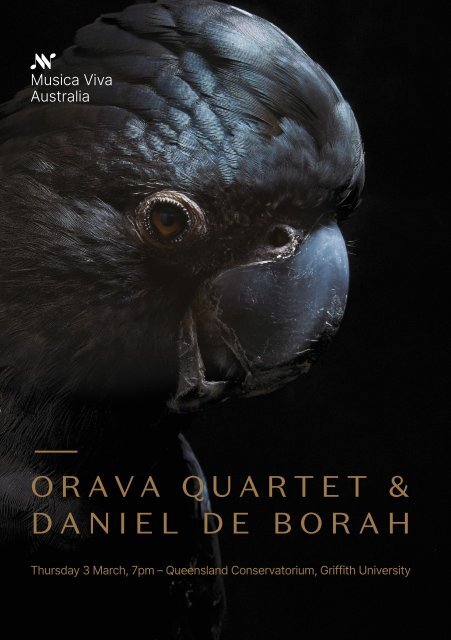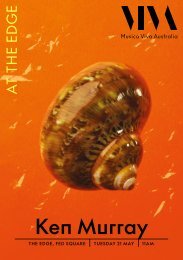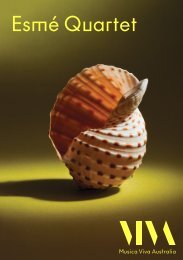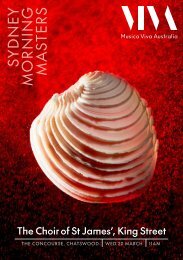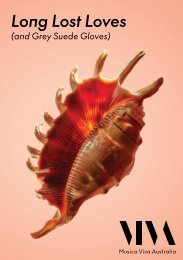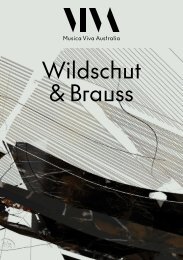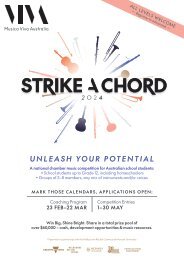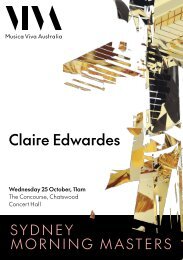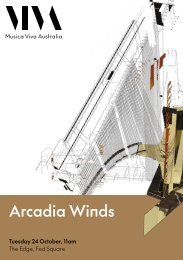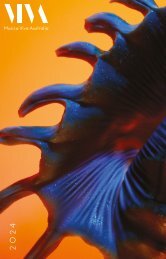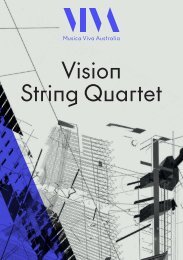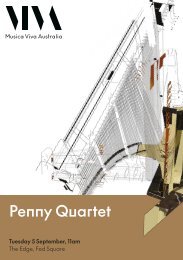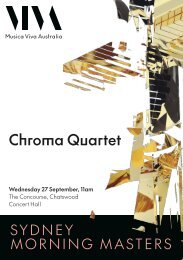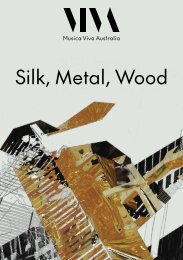Orava Quartet & Daniel De Borah Program Guide | March 2022
Create successful ePaper yourself
Turn your PDF publications into a flip-book with our unique Google optimized e-Paper software.
—<br />
ORAVA QUARTET &<br />
DANIEL DE BORAH<br />
Thursday 3 <strong>March</strong>, 7pm – Queensland Conservatorium, Griffith University
2
Musica Viva Australia acknowledges the Traditional Custodians of the many lands on<br />
which we meet, work, and live, and we pay our respects to Elders past and present –<br />
people who have sung their songs, danced their dances and told their stories<br />
on these lands for thousands of generations, and who continue to do so.<br />
PROGRAM<br />
TRAD NORDIC (Faroe Islands/Fanø, <strong>De</strong>nmark)<br />
Ye Honest Bridal Couple / Sønderho Bridal Trilogy – Part I<br />
(arr. Danish String <strong>Quartet</strong>)<br />
5 min<br />
Erwin SCHULHOFF (1894-1942)<br />
String <strong>Quartet</strong> No. 1 (1924)<br />
I Presto con fuoco<br />
II Allegretto con moto e con maliconia grotesca<br />
III Allegretto giocoso alla Slovacca<br />
IV Andante molto sostenuto<br />
Wojciech KILAR (1932-2013)<br />
Orawa (1988)<br />
Robert SCHUMANN (1810-1856)<br />
Piano Quintet in E-flat major, op 44 (1842)<br />
I Allegro brillant<br />
II In modo d’una marcia. Un poco largamente<br />
III Scherzo: Molto vivace<br />
IV Allegro ma non troppo<br />
18 min<br />
8 min<br />
30 min<br />
|<br />
3<br />
|<br />
<strong>Daniel</strong> Kowalik<br />
David Dalseno<br />
Thomas Chawner<br />
Karol Kowalik<br />
violin<br />
violin<br />
viola<br />
cello<br />
Meet the Artists<br />
after the concert.<br />
<strong>Daniel</strong> de <strong>Borah</strong><br />
piano<br />
With special thanks to the Producers’ Circle and the Amadeus Society for their support<br />
of the <strong>2022</strong> Concert Season, and to our Concert Champions Ian and Cass George.
ABOUT THE ARTISTS<br />
<strong>Orava</strong> <strong>Quartet</strong><br />
|<br />
4<br />
|<br />
The <strong>Orava</strong> <strong>Quartet</strong> has been hailed by<br />
Limelight magazine as ‘the most exciting<br />
young quartet on the block’ and predicted<br />
by The Australian to become ‘one of<br />
Australia’s proudest cultural exports’.<br />
Earning a reputation and devoted following<br />
for their thrilling performances, the <strong>Quartet</strong><br />
– brothers <strong>Daniel</strong> and Karol Kowalik (violin<br />
and cello), violinist David Dalseno and<br />
violist Thomas Chawner – bring their<br />
unique sound and breathtaking intensity to<br />
the classics and lesser-known works of the<br />
string quartet canon.<br />
The <strong>Quartet</strong> was selected by <strong>De</strong>utsche<br />
Grammophon for its historic, first<br />
Australian recording release in 2018. <strong>Orava</strong><br />
<strong>Quartet</strong> has performed in North America<br />
– including Canada in 2019 for the Festival<br />
International Hautes-Laurentides and<br />
Music and Beyond Festival (Ottawa) – and<br />
Asia, the UAE and New Zealand, working<br />
closely with the world-renowned Takács<br />
<strong>Quartet</strong> in the USA and winning top prizes<br />
at the 2013 Asia-Pacific Chamber Music<br />
Competition.<br />
Brisbane-based, <strong>Orava</strong> <strong>Quartet</strong> perform<br />
across the country, including in Sydney<br />
Opera House’s Utzon Music Series,<br />
Melbourne Recital Centre, Australian<br />
Festival of Chamber Music, for New<br />
Zealand Festival, VIVID Sydney with Sufjan<br />
Stevens, the BBC Proms and Melbourne<br />
Festivals and Queensland Music Festival.<br />
In <strong>2022</strong>, the <strong>Quartet</strong> proudly continue in<br />
their eighth year as Camerata’s Artistin-Residence,<br />
and resident quartet<br />
for Bangalow Music Festival, with<br />
performances at Queensland Performing<br />
Arts Centre, Empire Theatres Toowoomba,<br />
Canberra International Music Festival, for<br />
Musica Viva Australia, Melbourne Recital<br />
Centre, UKARIA Cultural Centre (Adelaide),<br />
Blackheath Chamber Music and Bangalow<br />
Music Festivals (NSW), and Riverside<br />
Theatres (Sydney) with pianist Simon<br />
Tedeschi. The <strong>Orava</strong>s’ highly anticipated<br />
second album is due for release in late<br />
<strong>2022</strong>, along with the premiere of a new<br />
string quartet by Elena Kats-Chernin AO.
© Keith Saunders<br />
<strong>Daniel</strong> de <strong>Borah</strong> piano<br />
<strong>Daniel</strong> de <strong>Borah</strong> is recognised as one<br />
of Australia’s foremost musicians,<br />
consistently praised for the grace,<br />
finesse and imaginative intelligence of<br />
his performances. His busy performance<br />
schedule finds him equally at home as<br />
concerto soloist, recitalist and chamber<br />
musician.<br />
Since his prize-winning appearances<br />
at the 2004 Sydney International Piano<br />
Competition, <strong>Daniel</strong> has given recitals on<br />
four continents and toured extensively<br />
throughout the United Kingdom and<br />
Australia. As a concerto soloist he has<br />
appeared with the English Chamber<br />
Orchestra, London Mozart Players,<br />
Royal Philharmonic Orchestra, Australian<br />
Chamber Orchestra and the Sydney,<br />
Melbourne, Queensland, Adelaide and<br />
Auckland Symphony Orchestras.<br />
An avid chamber musician, <strong>Daniel</strong> has<br />
enjoyed fruitful collaborations with many<br />
leading soloists including Vadim Gluzman,<br />
Andrew Haveron, Dale Barltrop, Kristian<br />
Winther, Baiba Skride, Li-Wei Qin, Nicolas<br />
Altstaedt, Umberto Clerici, Roderick<br />
Williams, Steve Davislim and Andrew<br />
Goodwin. His festival appearances have<br />
included the Musica Viva Festival, Adelaide<br />
Festival, Huntington Estate Music Festival<br />
and the Australian Festival of Chamber<br />
Music. <strong>Daniel</strong> is a founding member of<br />
Ensemble Q, ensemble-in-residence at<br />
the Queensland Conservatorium Griffith<br />
University since 2017.<br />
During his studies <strong>Daniel</strong> won numerous<br />
awards including 3rd Prizes at the 2004<br />
Sydney International Piano Competition,<br />
the 2001 Tbilisi International Piano<br />
Competition and the 2000 Arthur<br />
Rubinstein in Memoriam Competition<br />
in Poland. In 2005 he was selected for<br />
representation by the Young Classical<br />
Artists Trust, London. <strong>Daniel</strong> is also a past<br />
winner of the Australian National Piano<br />
Award and the Royal Overseas League<br />
Piano Award in London.<br />
Born in Melbourne in 1981, <strong>Daniel</strong> studied<br />
at the Liszt Academy of Music in Budapest,<br />
the St Petersburg State Conservatory and<br />
the Royal Academy of Music, London.<br />
His teachers have included Zsuzsa Esztó,<br />
Mira Jevtic, Nina Seryogina, Tatyana<br />
Sarkissova and Alexander Satz. <strong>Daniel</strong><br />
lives in Brisbane where he serves as Head<br />
of Chamber Music at the Queensland<br />
Conservatorium, Griffith University.<br />
|<br />
5<br />
|
ABOUT THE MUSIC<br />
|<br />
6<br />
|<br />
The Danish String <strong>Quartet</strong> writes:<br />
Folk music is the music of all the small<br />
places. It is the local music, but as such<br />
it is also the music of everywhere and<br />
everyone. Like rivers, the melodies and<br />
dances have flowed slowly from region to<br />
region: whenever a fiddler stumbled on a<br />
melody, he would play it and make it his<br />
own before passing it on. You don’t own a<br />
folk tune; you simply borrow it for a while.<br />
We have borrowed and arranged a<br />
selection of tunes that are all very close to<br />
our hearts. We perform them as a string<br />
quartet, one of the most powerful musical<br />
vehicles we know of. The string quartet is<br />
a pure construct: four simple instruments<br />
made of wood. But in all its simplicity, the<br />
string quartet is capable of expressing a<br />
myriad of colours, nuances and emotions<br />
– just like folk music. Our idea is to marry<br />
these two simple but powerful things, the<br />
folk music and the string quartet. Normally<br />
the string quartet has been reserved for<br />
the classical masters. Now we want to<br />
see what happens when we let the Nordic<br />
folk music flow through the wooden<br />
instruments of the string quartet.<br />
Does it work? We hope so. And remember:<br />
we simply borrowed these tunes. They<br />
have already been returned.<br />
© DANISH STRING QUARTET 2014<br />
Like many composers of his generation,<br />
Erwin Schulhoff’s life was deeply scarred<br />
by war. After studying piano, theory and<br />
composition in Prague from a very early<br />
age (he was first recommended to begin<br />
studies at the age of seven by the great<br />
Antonín Dvořák), he was conscripted into<br />
the Austrian Army at the age of 20. The<br />
young composer saw action in Hungary<br />
and in Russia, and after suffering shrapnel<br />
wounds in his hands, was retrieved from an<br />
Italian prisoner of war camp in 1918.<br />
In 1919, disenchanted by the<br />
establishment, Schulhoff moved to<br />
Dresden and immersed himself in an<br />
eclectic mix of compositional styles,<br />
inspired by the greatest progressive<br />
thinkers of the time. He was attracted<br />
by the intense atonality of Schoenberg<br />
and the Second Viennese School, and<br />
would later be introduced to the Berlin<br />
Dada movement – an artistic community<br />
preoccupied with subversion, parody and<br />
irreverent ‘anti-art’. Schulhoff’s eccentric<br />
works include The Bass Nightingale, a<br />
solo sonata for contrabassoon imitating<br />
birdsong, and In Futurum for solo piano,<br />
which anticipates the work of John Cage<br />
and consists only of highly specific and<br />
nonsensical rests. No notes, just two<br />
minutes of complete silence.<br />
Not long after returning to Prague,<br />
Schulhoff became increasingly inspired by<br />
the work of his countryman Leoš Janáček,<br />
and his first <strong>Quartet</strong> (1924) represented a<br />
renewed populist approach that combined<br />
rich folk melodies with a darker underlying<br />
tension. The piece is concise yet vibrant<br />
– straight out of the blocks in the Presto<br />
con fuoco first movement, a driving pulse<br />
of brash energy hints at spiky dissonance<br />
while creating brilliant melodies for the<br />
whole ensemble.<br />
The direction for ‘grotesque melancholy’<br />
in the title of the second movement<br />
(Allegretto con moto e con malinconia<br />
grotesca) indicates a touch of sarcasm,<br />
perhaps represented best by the<br />
melodramatic mock-operatic viola<br />
interludes and the accompanying sound of<br />
the windswept Bohemian Forest. The third<br />
movement is to be played alla Slovacca,<br />
and Schulhoff achieves a brilliant effect in<br />
manipulating the earthy Bohemian central<br />
theme.
The fourth movement, Andante molto<br />
sostenuto, steers away from the intense<br />
energy of the first three movements<br />
but reveals an eerie darkness. After<br />
a passionate interchange of thematic<br />
material, the flame of the piece is gradually<br />
consumed by darkness around it and<br />
vanishes into nothingness.<br />
ROB HANSEN © 2016<br />
Wojciech Kilar’s Orawa is a piece that my<br />
brother <strong>Daniel</strong> and I grew up listening to<br />
as children, and which ultimately became<br />
our namesake. Orawa refers to a region<br />
near the Polish-Slovak border marked<br />
by rugged, mountainous terrain, and this<br />
piece is the final work in Kilar’s so-called<br />
‘Tatra Mountain Works’. It is inspired by<br />
Polish highland folklore and portrays the<br />
dramatic landscape, as well as the river<br />
that runs through it. In his own words<br />
about the work, Kilar had ‘dreamed of<br />
creating a piece inspired by a highlander<br />
band. It is pretty much a piece for a<br />
magnified folk band and one of the rare<br />
examples where I’ve been happy with my<br />
work.’<br />
© KAROL KOWALIK<br />
The early 1840s were productive and<br />
exciting years for Schumann. In 1840,<br />
following an acrimonious legal battle with<br />
his teacher, and unwilling future fatherin-law,<br />
Friedrich Wieck, Schumann had<br />
married his beloved Clara. Inspired and<br />
encouraged by her, he turned his attention<br />
from the solo piano music that had<br />
dominated his output to compose songs,<br />
orchestral works and, particularly in 1842,<br />
chamber music; the three String <strong>Quartet</strong>s<br />
Op. 41, the Piano <strong>Quartet</strong> Op. 47, the first<br />
version of the Fantasiestücke Op. 88<br />
and the Piano Quintet Op. 44, which was<br />
written during September and October.<br />
Schumann’s was the first Piano Quintet<br />
that can truly be called great, and it<br />
did much to establish his name as a<br />
composer. Clara, the Quintet’s dedicatee,<br />
was delighted. However, owing to her<br />
ill-health at the time of the work’s private<br />
premiere on 6 <strong>De</strong>cember, Schumann’s<br />
friend Mendelssohn stepped in to play<br />
the demanding piano part at sight,<br />
although Clara participated in the first<br />
public performance on 8 January 1843.<br />
Extraordinarily, the Quintet gained the<br />
approbation of Berlioz, who himself wrote<br />
no chamber music and was critical of<br />
Mendelssohn.<br />
Liszt, who unexpectedly visited the<br />
Schumanns in Leipzig, remarked<br />
condescendingly, ‘No, no, my dear<br />
Schumann, this is not the real thing:<br />
it is only Kapellmeister music’. This<br />
opinion and some disparaging remarks<br />
about Mendelssohn greatly offended<br />
Schumann, yet Liszt’s oblique reference<br />
to the influence of Bach was not wholly<br />
wide of the mark. Robert and Clara had<br />
together enjoyed playing and analysing<br />
his Well-Tempered Clavier. ‘Our fugal<br />
studies continue,’ she noted in her diary.<br />
‘Every time we play one it becomes more<br />
interesting for me. Such great art with such<br />
a natural flow.’<br />
The Piano Quintet has affinities with the<br />
seventh prelude and fugue from Book 1,<br />
with which it shares its key and, possibly,<br />
also the distinctive pair of upwardleaping<br />
intervals with which it opens. But<br />
where Bach achieves a yearning mood,<br />
Schumann’s approach is much bolder and<br />
extroverted, exploring a wider range of<br />
emotional ground overall.<br />
The first movement weaves two prominent<br />
themes, the striding pair of rising intervals<br />
and a more lyrical second subject, into<br />
a tightly argued yet expansive Sonataallegro<br />
in which the piano contributes to<br />
the rich Romantic instrumental textures<br />
|<br />
7<br />
|
of the four strings with ebullient interplay.<br />
There is scarcely a bar in which the piano<br />
is not heard, yet its part is completely<br />
integrated into the whole.<br />
The second movement has a somewhat<br />
Schubertian melancholy while<br />
foreshadowing the unstable mood of<br />
Mahler’s funereal marches. Its halting<br />
opening theme, poco largamente, is twice<br />
interrupted, first by a more lyrical passage,<br />
then by an agitato section. <strong>De</strong>spite these<br />
contrasts, the entire movement is unified<br />
by Schumann’s ingenious thematic<br />
development.<br />
A dashing Scherzo unleashes much<br />
excitement with energetically running<br />
scales, again twice interrupted by<br />
contrasting passages. The first Trio<br />
is lyrical in character, the second has<br />
a muscular folk character resembling<br />
Beethoven or Brahms in bucolic mood.<br />
Mendelssohn had suggested that the<br />
second Trio should be ‘something livelier’<br />
than Schumann had originally composed.<br />
Perhaps following the example of<br />
Mendelssohn, whose String <strong>Quartet</strong> in<br />
E-flat major Op. 13 had played the same<br />
trick, the Finale opens away from the<br />
home key of the work, returning to it at<br />
the end when the main theme from the<br />
opening movement is recalled. Schumann<br />
caps this sonata rondo, in which elements<br />
from the preceding movements are<br />
brilliantly developed, with a double fugue.<br />
Unsurprisingly, many more are inclined to<br />
agree with Clara, than with Liszt, that this<br />
is ‘magnificent – a work filled with energy<br />
and freshness’.<br />
© STEPHEN SCHAFER<br />
We’ve been taking orders and delivering fine<br />
wines to homes all across Australia since 1974.<br />
You won’t find our wine in bottle shops - we’ve<br />
always preferred to cut out the middle man.<br />
If you’re in Mudgee, come and see us at our<br />
beautiful winery and vineyard, try our wines<br />
and enjoy delicious local produce and weekend<br />
lunches in the gardens and grounds.<br />
As a friend of Musica Viva Australia, you are a<br />
friend of ours too, so take 20% off your first<br />
Huntington Estate order with coupon code<br />
MVAFRIEND, online or in our charming Cellar<br />
Door.<br />
641 ULAN ROAD BUCKAROO NSW 2850<br />
WWW.HUNTINGTONESTATE.COM.AU
ABOUT MUSICA VIVA AUSTRALIA<br />
At Musica Viva Australia, we’re proud to be<br />
one of the world’s leading presenters of<br />
chamber music. Passionate about creating<br />
a vibrant musical future for Australia’s artists<br />
and audiences, we feel fortunate to nurture<br />
both established and emerging talent from<br />
around the country. We’re also committed<br />
to learning from our First Nations friends<br />
and colleagues how to most effectively<br />
include in our work the many peoples and<br />
languages that, together, comprise the<br />
oldest living culture in the world.<br />
Musica Viva Australia is committed to the<br />
future of classical music, and to being at<br />
the forefront of its evolution. Our dedication<br />
to the commissioning and programming<br />
of new Australian works is key to our<br />
vision, and through eclectic and thoughtful<br />
programming, we endeavour to lead<br />
the industry in presenting concerts that<br />
challenge and thrill all audiences.<br />
Passionate about creating community<br />
through music, we are committed to<br />
bringing unforgettable shared experiences<br />
from extraordinary local and international<br />
musicians to our audiences in capital cities,<br />
regional centres, and remote communities.<br />
As one of the leading providers of music<br />
education in Australia, Musica Viva has<br />
been proudly bringing music to schools<br />
for more than 40 years, helping shape<br />
the lives of generations of Australian<br />
children and reaching close to 300,000<br />
students annually. Dynamic performances<br />
by culturally-diverse ensembles are<br />
complemented by comprehensive lesson<br />
plans, interactive content, and professional<br />
development for teachers, building the<br />
capacity of schools to inspire, teach, and<br />
instil a love of music.<br />
Melbourne’s Finest<br />
Afternoon Tea Experience<br />
Discover The Langham Afternoon Tea at Aria Bar & Lounge and<br />
indulge in a selection of British tea time classics with a modern twist.<br />
#LovingLangham #CelebrateTheEveryday<br />
1 Southgate Avenue, Southbank, Vic 3006 Australia<br />
T (61) 8696 8888 F (61) 9690 5889<br />
langhamhotels.com/melbourne
QLD SUPPORTERS<br />
|<br />
10<br />
|<br />
CUSTODIANS<br />
Anonymous (3)<br />
LEGACY DONORS<br />
The late Steven Kinston; Anonymous<br />
ENSEMBLE PATRONS<br />
Our artistic vision for <strong>2022</strong> is made possible<br />
thanks to the extraordinary generosity of our<br />
Ensemble Patrons, each of whom supports<br />
the presentation of an entire national tour for<br />
our <strong>2022</strong> Season.<br />
Ian Dickson & Reg Holloway (Van Diemen’s Band)<br />
Anonymous (Paul Grabowsky & Andrea Lam)<br />
Peter Griffin AM & Terry Swann<br />
as part of The Travellers - Giving Circle<br />
(A Winter’s Journey)<br />
Australian Music Foundation (Z.E.N. Trio)<br />
Eleanore Goodridge OAM<br />
(Avi Avital & Giovanni Sollima)<br />
CONCERT CHAMPIONS<br />
The mainstage concerts of our <strong>2022</strong> Season<br />
are brought to life thanks to the generosity of<br />
our Concert Champions around the country.<br />
Ian & Cass George, Andrew & Kate Lister, Barry<br />
& Diana Moore, The Hon Justice A Philippides,<br />
Anonymous<br />
PRODUCERS’ CIRCLE<br />
Darin-Cooper Family Foundation<br />
MASTERCLASSES<br />
GIVING CIRCLE<br />
The Masterclasses Giving Circle is a group of<br />
generous donors whose collective support will<br />
enable the artistic development of the next<br />
generation of Australian chamber musicians.<br />
Nicholas Callinan AO & Elizabeth Callinan,<br />
Caroline & Robert Clemente, Ian & Caroline<br />
Frazer, Allan Myers AC QC & Maria Myers AC,<br />
Patricia H. Reid Endowment Fund, Andrew<br />
Sisson AO & Tracey Sisson, Mick & Margaret<br />
Toller, Anonymous (2)<br />
COMMISSIONS<br />
Musica Viva Australia acknowledges and<br />
celebrates those individuals and collectives who<br />
have generously committed to commissioning<br />
new music in <strong>2022</strong>/23 to be enjoyed by us all.<br />
In loving memory of Jennifer Bates; Julian<br />
Burnside AO QC & Kate Durham; The Barry Jones<br />
Birthday Commission; Michael & Fréderique Katz,<br />
in honour of Cecily Katz; Graham Lovelock & Steve<br />
Singer; DR & KM Magarey; Vicki Olsson; Tribe<br />
family in honour of Doug Tribe’s 75th birthday<br />
Musica Viva Australia also thanks the Silo<br />
Collective, the Ken Tribe Fund for Australian<br />
Composition, and the Hildegard Project for their<br />
support in bringing new Australian works to life.<br />
MAJOR GIFTS<br />
$20,000-$49,999<br />
Ian & Caroline Frazer, Andrea & Malcolm Hall-<br />
Brown, The Hon Justice A Philippides<br />
$10,000-$19,999<br />
Anonymous<br />
$5,000-$9,999<br />
Andrew & Kate Lister<br />
ANNUAL GIVING<br />
$1,000-$4,999<br />
George Booker & <strong>De</strong>nise Bond, Jill Boughen,<br />
Prof. Paul & Ann Crook, John & <strong>De</strong>nise Elkins,<br />
Robin Harvey, Lynn & John Kelly, Dr Helen Kerr<br />
& Dr John Ratcliffe, Jocelyn Luck, Barry & Diana<br />
Moore, <strong>De</strong>bra & Patrick Mullins, Barbara Williams<br />
& Jankees van der Have<br />
$500-$999<br />
Janet Franklin, Prof Robert G Gilbert, Marie<br />
Isackson, M F Lejeune, Timothy Matthies &<br />
Chris Bonnily, Anthony Simmonds,<br />
Jianxin Zhao & Faye Liu, Anonymous (4)<br />
We sincerely appreciate the<br />
generous support we receive<br />
from our incredible community,<br />
and encourage you to scan<br />
the QR code to see a full list of<br />
donors over $500 to Musica<br />
Viva Australia.<br />
We thank all our audience members who<br />
donated the value of their cancelled tickets<br />
towards the Artists’ Fund.
PARTNERS<br />
Perth Concert Series<br />
Sydney Morning Masters Series<br />
Law Firm<br />
Chartered Accountants<br />
Piano & Tuning<br />
Media<br />
|<br />
11<br />
|<br />
Wines<br />
Hotels<br />
National Government<br />
Musica Viva Australia is a not-for-profit organisation endorsed<br />
by the Australian Taxation Office as a <strong>De</strong>ductible Gift Recipient<br />
and registered with the Australian Charities and Not-for-profits<br />
Commission (ACNC).
2<br />
V<br />
0<br />
I<br />
2<br />
V<br />
2<br />
A<br />
VAN DIEMEN’S BAND<br />
Touring: 26 April–14 May<br />
musicaviva.com.au/van-diemens-band | 1800 688 482<br />
—<br />
Australia’s finest early music specialists invite you to experience<br />
the beautiful melding of cultures in Europe’s historical borderlands.<br />
—<br />
With special thanks to our Ensemble Patrons Ian Dickson & Reg Holloway.


